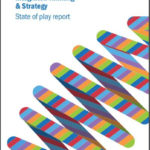
The transparency that comes from corporate responsibility reporting can help us create a better world. That was the message of Tim Mohin (CEO GRI) to the people he met at the World Economic Forum (WEF) Annual meeting in Davos. As a first time WEF participant, He was amazed at the concentration of leaders, from all over the world, who are committed to improving the state of the world. The theme of this year’s meeting was Creating a Shared Future in a Fractured World.
Read his notes:
But what does that actually mean?
For me, it says we live in a world with persistent problems, like climate change, poverty and gender inequality, but that it’s also a world with the tools to overcome these challenges. The WEF meeting in Davos brings together people that can make a difference, and help create a brighter future.
The Sustainable Development Goals (SDGs) are a good example. They are the global framework for conquering the world’s biggest challenges. But to achieve them, we urgently need companies to incorporate them into their corporate responsibility activities. We also need investors to shift their capital towards more responsible businesses that make positive contributions towards the goals.
Corporate sustainability reporting can and does help on both of these fronts. But the way the practice is currently done, falls short. Let me explain.
Recently, the non-profit I lead, the Global Reporting Initiative (GRI), compared the top twenty most commonly disclosed GRI indicators, against those most commonly requested by investors. Alarmingly, there is little overlap between what companies report and what their investors want to know. More on this later in the year, but I think this divide between what companies report and the information that investors want, is one of the most important fractures in our world that we urgently need to mend. By aligning capital with sustainable business practices, we can enlist the power of capitalism to lift all of humanity. Bridging this gap is one of our top priorities at GRI. While we don’t have all of the answers, here are some thoughts on how the practice of ESG disclosure or sustainability reporting needs to change to create a shared narrative between companies and investors.
Increasing the quantity and quality of corporate transparency
It’s no surprise for me call for more sustainability reporting. But reporting is a means to an end not and end itself. The goal is to advance sustainable development. It’s the North Star that guides all our work in this space. Increasing the quantity and quality of corporate transparency, around the world’s most pressing issues, is an essential first step in creating a shared narrative about these problems. While reporting is commonplace among large companies, it is not all that common among small and medium-sized enterprises (SMEs) that are a huge part of the global economy.
And even when we look at large companies, we see that corporate reporting on sustainability issues can be improved to make it more user-friendly. All too often, companies release 100-page sustainability reports that are full of old data that doesn’t show how or if the information is being used to contribute to improving the world. I have written and spoken extensively about how reporting needs to become more concise, consistent, comparable and current. And ultimately this is what investors want from corporate reporting on ESG issues.
The investor side of the equation
Society is demanding that companies… serve a social purpose. To prosper over time, every company must not only deliver financial performance, but also show how it makes a positive contribution to society.
This recent quote from BlackRock Chairman and CEO Larry Fink is noteworthy. In fact, this sentiment is the reason that GRI was founded 20 years ago. Through corporate transparency, we help companies plot a course toward continued profits, while simultaneously protecting the environment and society. But it’s not enough to just speak these words. We need investors like Black Rock to start walking the talk and to move their capital away from endeavors that create profits at the expense of people and the planet.
We need all investors to realize that a single-minded focus on financial gains, without regard for the broader impacts, misses the mark. When this understanding trickles down to corporate reporting, it means that investors need to become much more educated and interested in ESG information (which means taking a longer-term focus), and we need companies to issue data that investors want to use.
Companies and investors uniting around the SDGs
Governments, companies, investors, civil society and others all have a role to play in achieving the SDGs. Some businesses have annual revenues larger than the GDPs of many countries and they have supply chains that stretch around the world. So clearly the private sector is essential to accomplishing the global goals.
Yet many companies are confused by the SDGs – and for good reason. Many of the SDGs were written with nation-states in mind and have targets with no direct application to companies. On top of that, many companies already have well-established sustainability programs. So the big question is how can we translate the global goals into an actionable agenda for the private sector?
There is good news: at Davos, Lise Kingo, Executive Director of the UN Global Compact, and I held a roundtable, to discuss our project on Business Reporting on the SDGs. With this project, we are working with companies and other stakeholders to empower the private sector to not only incorporate the goals into their corporate responsibility reporting, but to take concrete action to make the SDGs a reality.
We’ve already published two documents that companies can use to engage with the SDGs. The first is The SDG Compass (published in partnership with the World Business Council for Sustainable Development), which helps companies map their existing sustainability programs to the global goals. The second is An Analysis of the Goals and Targets, which is an inventory of possible actions and disclosures for each of the 169 targets under all of the SDGs. Now we are working on A Practical Guide to Defining Priorities and Reporting, which will offer a structured approach to help companies identify and prioritize the actions they will take and how to use their reporting to drive action. We expect to publish this third document in July.
A Shared Future
WEF Davos 2018 was an amazing experience. World leaders, Nobel Prize winners, corporate CEOs, civil society and opinion leaders from every walk of life came together to plot a fruitful path forward. Some of the sessions dealt with the immense scale of the challenges we face. Others focused on how we have never lived as well as we do today. This is our fractured world. We are doing well, but we must do much better.
Transparency, while not a panacea, is an engine of good. When information is accessible, it makes for better choices. And better choices will help us all succeed. While we have come a long way with corporate sustainability reporting, there is much more to do to get this information to where it can do the most good.
Our shared future will be very bright, as long as leaders continue to seek understanding, collaboration and cooperation, which is the entire point the annual meeting of the World Economic Forum.



